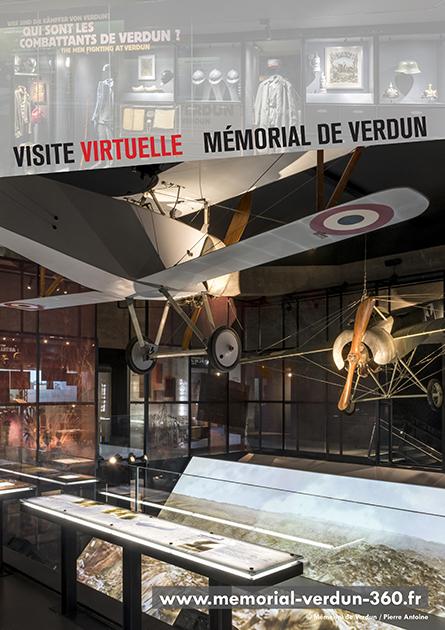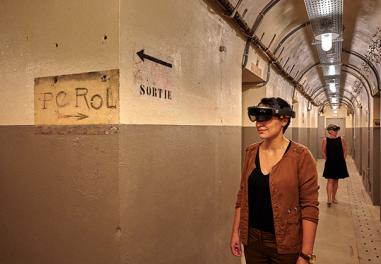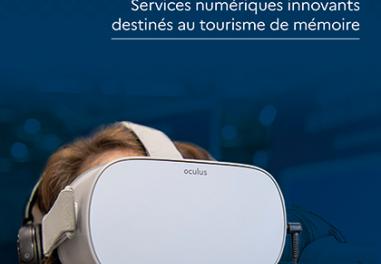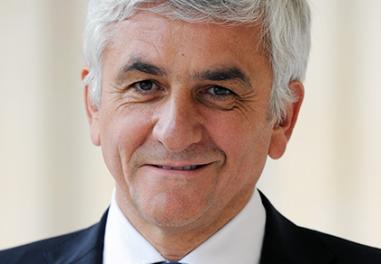Verdun Memorial
As part of its reopening in time for the Battle of Verdun’s centenary in February 2016, Verdun Memorial has installed new digital devices catering to every type of public. The technological upgrade is continuing apace, spurred on by the pandemic.

The digital tools and resources developed by the Memorial to offer an alternative perspective of the Battle of Verdun as well as the First World War was originally aimed at school students. In 2017 and 2018, a serious game type app for iPad was created in partnership with the CANOPÉ network aimed at a primary school audience. Entitled “War reporter in Verdun”, it invites children to assume the role of a journalist from a neutral country, Switzerland in this case, who has been sent out to write a news story about the Battle of Verdun. In addition, following a partnership set up with the Université de Lorraine, three MOOCs (Massive Open Online Course), each a month long, were produced between 2016 and 2018 and made available on the “France Digital University” (FUN) platform. These courses, entitled “On the footsteps of Verdun combatants: 1916-2016", “Verdun 1917-1918: forgotten battles? French, German and American troops in the eye of the storm” and “Verdun past and present” have been taken by over 18,000 people. All 69 videos and 45 accompanying documents have been posted on the Verdun Memorial website and its YouTube channel. The Covid pandemic in 2020 and 2021 has been a catalyst for further digital productions such as a new virtual visit of the museum. This means that remote visitors are able to take a tour of the different areas of the memorial while getting a feel of the site’s atmosphere and surroundings from afar. Users can navigate the site at 360 degrees and take in high-resolution views of the displays and the objects presented inside them. Available in two formats, one free visit and one for the reasonable sum of €3, the app offers a variety of content including historical explanations, archival images, audio and video testimonials and features on iconic objects in the museum’s collection.
When the cultural and tourist institutions were forced to close, the events planned as part of the cultural programme in connection with the fortifications were also converted to digital format. The film screenings and Q&A sessions for the documentaries “Les Forts de Verdun” (2018) and “Maginot vs Siegfried: la guerre des lignes” (2018) were also moved online. A decision that proved a big success. The webinars are now uploaded to the museum’s YouTube channel and can be watched time and time again. To maintain the connection between visitors and the Verdun Memorial collection as well as promote the latest acquisitions, an “object of the month” was featured on its own page on the memorial’s website and as part of the “Discover the collections” web series. These capsule videos shine additional spotlights on the object on display.
And that’s not all as the museum has recently also been busy working on new productions. Following the plans to restructure the top floor of the Memorial, the decision was made to introduce a virtual reality installation bringing a new element of interpretation to the Verdun battlefield. Equipped with five virtual reality headsets, the new service gives visitors a glimpse of the local landscape through the lens of three different points in time: at the outbreak of war (August 1914), during the Battle of Verdun (October 1916) and the construction of the Ossuary in Douaumont (1927). The installation came into service in June.
During its period of closure, Verdun Memorial found the time to improve and develop its digital resources and tools to maintain and strengthen its connection with visitors by continuing to provide scientific content, accessible to all, and to encourage people to come back to the site when it reopens.
Articles of the review
-
The file

Digital remembrance tourism
Digital has slowly crept into our museums over the last thirty years. While the Covid-19 pandemic has certainly quickened the pace of this trend, “remembrance tourism 2.0” provides us with a clearer understanding of history while also increasing the appeal of remembrance destinations and sites linke...Read more -
The event

Call for digital proposals
To gain a clearer understanding of the link between remembrance tourism and digital technology, the Directorate for Heritage, Remembrance and Archives organised an online seminar held in early May 2021. The seminar was also an opportunity to unveil the names of the winners of the 2021-2021 call for ...Read more -
The interview

Hervé Morin
Former French minister of defence, Hervé Morin was keen in his new role of President of the Regional Council of Normandy to promote the development of remembrance tourism as part of his policy. Regarding the digital transition, the region very early on made the decision to help and support the opera...Read more

